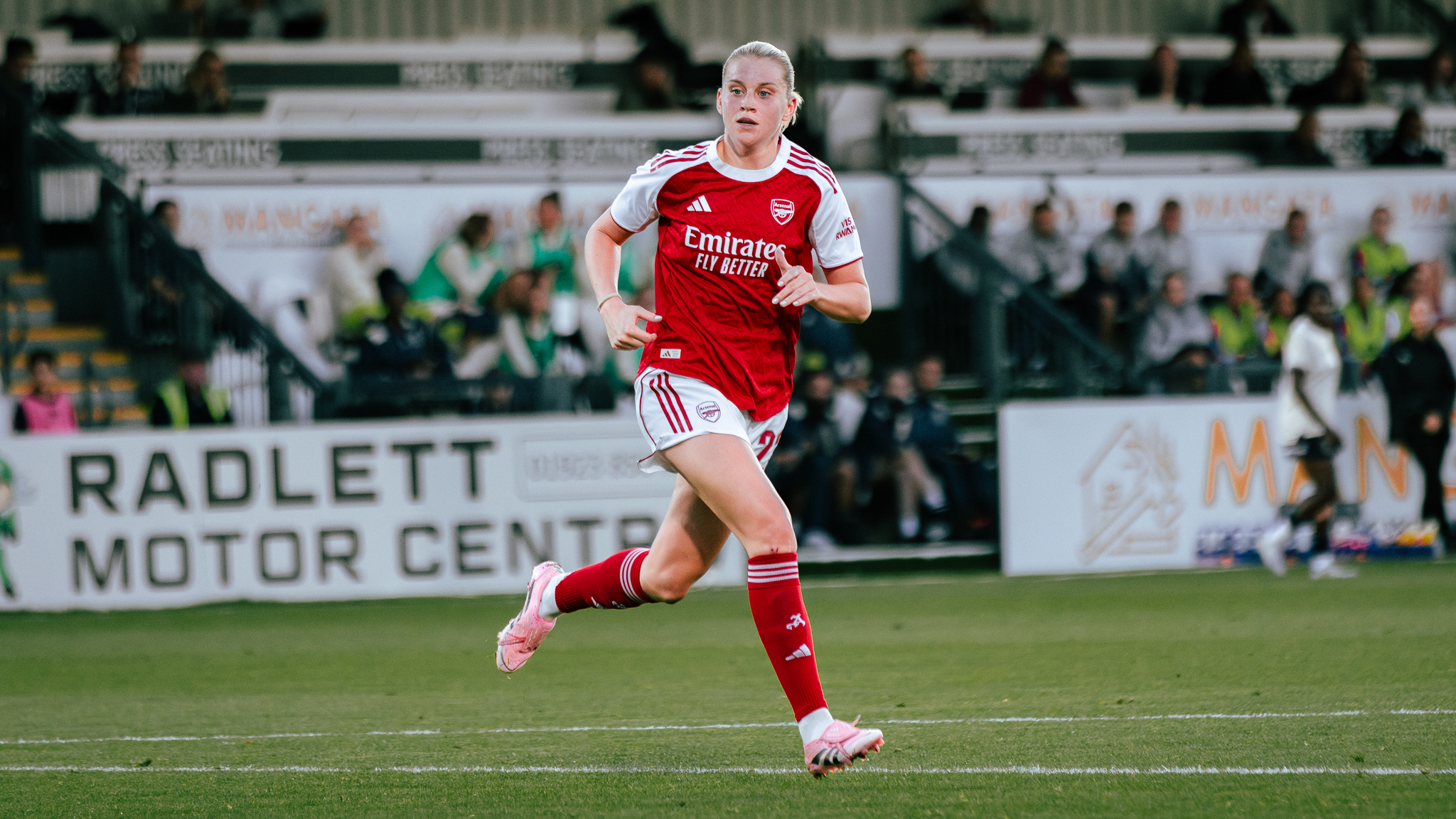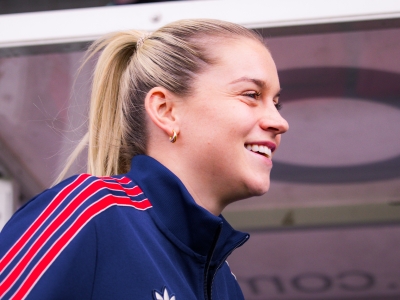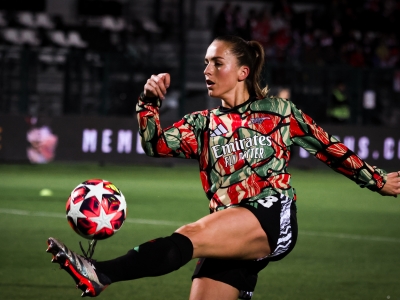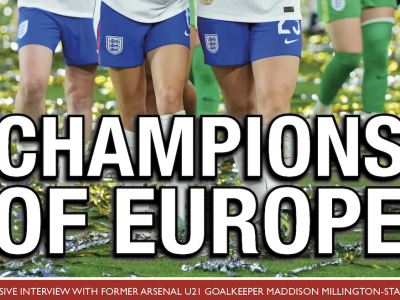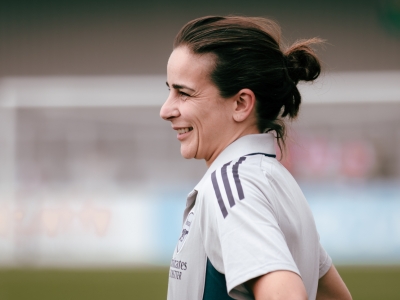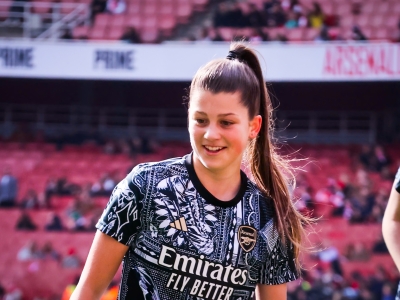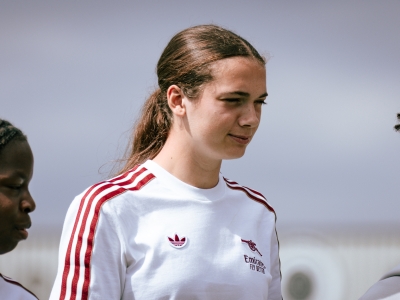Introduction:
The frontline is where a team’s intentions are made clear. How a side creates chances, applies pressure, and turns possession into goals tells us as much about their identity as any other part of the pitch. Under Renée Slegers, Arsenal’s attack has felt like the area of greatest change — sharper, more varied, and less predictable than in recent years.
This piece is the third and final part of my series Understanding Arsenal Under Renée Slegers. Having already looked at the midfield conundrum and the defensive backbone, I’ll now focus on the forwards — their roles, tactical patterns, and what last season’s combinations reveal about Slegers’ vision in the final third. We’ll also look ahead to this season, where squad depth and rotation will make the attack one of Arsenal’s biggest strengths.
The Frontline Under Slegers:
Looking back across last season, the picture that emerges is one of variety. Arsenal didn’t lean on a fixed front three — they used different combinations depending on the opponent, and that adaptability became a strength. The numbers show where things clicked, which partnerships worked, and how different profiles shaped the attack.
Alessia Russo as the Anchor
Russo started 26 times, winning 20 of those matches, making her Arsenal’s most reliable starting point. She was directly involved in goals in 17 of those starts, and Arsenal averaged 2.4 goals per game when she was on the pitch. Russo didn’t just finish chances — she structured the attack. Whether leading the line or dropping into the number 10 role, she created the framework for others to play around, and Arsenal’s offensive cohesion noticeably dropped in her absence.
Stina Blackstenius: The Chaos Factor
When Blackstenius started, Arsenal averaged almost three goals per game, but the matches tended to be more open. Her pace stretched defenses and created space for teammates, though the team sometimes lost control in transition. In high-scoring games, such as the 5–2 win over Villa and the 4–3 victory against City, she thrived by turning chances into goals. As a substitute, she proved even more effective, often providing decisive strikes against tired defenses.
Caitlin Foord: The Connector
Foord made 22 starts, with Arsenal failing to score only once, away at Chelsea. Comfortable on either flank, her composure and ball-carrying ability gave balance to whichever attacking trio she was part of. She may not always grab headlines, but her presence strongly correlated with Arsenal avoiding flat attacking displays, acting as the glue that kept the attack cohesive.
Beth Mead’s Transition Role
Mead started 14 times, winning nine matches, and was particularly effective against lower-tier WSL teams such as Palace, Bristol, and Leicester, scoring 14 goals across three games. Against stronger opponents like Chelsea, Lyon, Liverpool, and City, her starting record was mixed. She still contributed goals and assists, but often looked more effective as an impact sub, bringing energy and directness to games that were already stretched.
Mariona Caldentey’s Control
Mariona played 20 times, often nominally wide but frequently drifting centrally. While her goals came in key games against Bayern, City, and Lyon, her primary impact was in shaping and slowing the attack, helping Arsenal maintain control. The team conceded less when she started, not due to defensive work but because her ball retention higher up the field allowed the side to dictate tempo and shape the game.
Chloe Kelly: The New Edge
Kelly’s arrival added instant directness, with seven starts producing six wins, contributing goals or assists in most appearances. She pressed, shot, and added a vertical edge to Arsenal’s attack, representing a deliberate shift from Slegers’ previous approach, prioritizing bravery and decisiveness in the final third.
Combinations That Defined the Season
The Russo–Foord–Mariona trio started seven times, winning six and drawing once, scoring 17 goals and conceding just two, representing the “control” combination. Russo–Foord–Mead started six times with two wins and four losses, scoring 13 and conceding 14, a “high-risk” trio effective against weaker sides but exposed against stronger teams. Russo–Foord–Kelly began five times, winning four, losing one, scoring 16 and conceding nine, the “new-look” combination, direct and dangerous but still bedding in.
What It Tells Us
Russo served as the reference point for most successful combinations. Blackstenius is most effective as an impact player, thriving late in games. Foord’s consistency keeps attacks alive, Mead remains valuable but situational against top sides, Mariona provides control and tempo, and Kelly adds fearlessness. Slegers’ rotation was strategic, tailoring the frontline to the opponent with either control, chaos, or directness, making Arsenal harder to predict and giving them multiple attacking avenues.
Olivia Smith – What She Brings From Liverpool & How She Fits at Arsenal
At Liverpool in 2024/25, Smith scored nine goals in 25 appearances across all competitions, leading her team in goals, and netted seven in 20 WSL starts. She attempted roughly 50 shots, leading Liverpool in volume, and recorded 92 touches in the opposition box, highlighting her ability to get into dangerous positions. She completed around 57% of her 61 take-ons, demonstrating one-on-one threat, and overperformed her expected goals by 2.6, showing efficiency and composure in finishing. Though primarily central (62%), she also played on the right wing (37%), offering tactical flexibility.
In Slegers’ context at Arsenal, Smith brings volume and threat in the final third, complementing existing forwards while benefitting from better supply and service. Her directness and ability to force defenders into reactive situations align with Arsenal’s pressing and transition style. Her versatility allows tactical flexibility, while her efficiency and positioning suggest she could integrate seamlessly into Arsenal’s attacking structure, contributing beyond just secondary opportunities.
Individual Profiles in the 2025/26 Context:
Beth Mead
Her decision to stay this summer is one I loved. Arsenal didn’t need to lose depth, they needed to add to it, and Mead embodies that principle. We saw last season the impact she made off the bench: hungry, purposeful, determined to prove herself. Her conversations with Slegers were telling; a manager willing to be clear about roles, a player willing to fight for hers. What stands out is how she is again finding those central scoring positions, something she was doing regularly pre-injury. Her combinations with Frida Maanum and Stina Blackstenius also remain sharp. In a squad this deep, Mead isn’t guaranteed a starting place, but her importance hasn’t diminished.
Olivia Smith
Smith brings something Arsenal had been crying out for: a winger who wants to take players on, who is strong enough to hold them off, and who is fearless about shooting from distance. She is the player who shifts the rhythm of a game with one action. Already, she looks nailed on for the big nights, and the thought of her in Champions League fixtures is genuinely exciting. Arsenal have found their spark.
Chloe Kelly
Chloe Kelly has quickly become more than just a player. There is a sense of belonging with her, a mutual affection that makes her role more powerful than the numbers alone suggest. But her numbers were good too: goals, assists, positional intelligence. What stands out is her willingness, shared across the frontline under Slegers, to shoot. Arsenal’s increased goal tally last season owed much to that shift in mentality. No more hesitation. Kelly embodies it.
Caitlin Foord
Perhaps the most underrated of all. Foord’s recent form has been consistently strong, whether starting or coming from the bench. In pre-season she even led the line as a number nine, showing her versatility, but it is wide where she dominates: carrying, holding off defenders, and delivering composure in front of goal. She is not always first choice, but she is always an option who can swing a game. That pressure on starters is healthy, and Foord is the embodiment of Arsenal’s depth.
Alessia Russo
The anchor. Everything flows from Russo, and her new contract signals Arsenal’s intent to build around her. She scores, she assists, she creates space for others. More than anything, she brings a calm certainty to the frontline. Even in matches where goals don’t come, her contribution is undeniable. She is Arsenal’s reference point.
Stina Blackstenius
Still so valuable. Her role has shifted, but her impact hasn’t. Off the bench, against tired legs, she is lethal. Her runs in behind have improved, her finishing has sharpened, and she remains the player who can change the mood of a game instantly. Her Champions League final winner was the purest example of her importance: the headline name, the decisive moment.
Recruitment and the Future:
It feels strange to say, but the frontline is now the last area Arsenal need to think about in recruitment. A season or two ago, that would have been unthinkable. Depth is strong, quality is varied, and roles are clearly defined.
The considerations are longer term. What happens if Mead and Blackstenius don’t extend beyond this season? How do Michelle Agyemang and Rosa Kafaji return from their loans at Brighton? Do they fit into this system, or will they need more development? These are questions for later, not now. For now, the frontline is not a problem to fix, but a strength to trust.
And crucially, goals are no longer confined to the forwards. Midfielders contribute, fullbacks arrive high, defenders score from set pieces. It is a collective. That reflects Slegers’ approach: the system produces the chances, not just individuals.
Looking Ahead - Who Plays This Season?:
The season has already given us a glimpse. Russo set the tone with her strength and awareness, Kelly’s movement was intelligent and decisive, Smith looked electric on debut. Off the bench, Foord carried threat, Blackstenius found space, and Mead reminded everyone she is not done yet.
It makes projecting a “best XI” almost impossible, and that is the point. Arsenal now have a positive problem. The front three of Kelly, Smith and Russo looks like the emerging core, but form and rotation mean Foord and Mead are right there pushing. Blackstenius will remain decisive in Europe and late in league games. Maanum, Mariona and Pelova, from midfield, will continue to blur the lines of what “the attack” really is.
This is not about naming a front three and sticking with it. It is about options, flexibility, unpredictability. Arsenal now have that.
Conclusion - Understanding Arsenal under Renée Slegers:
Across this series, the picture has become clear. The midfield was the conundrum, the balance point where Slegers wrestled with control and creativity. The defence provided the backbone, stability with Van Domselaar and Williamson at the heart. And the frontline? It is the release valve, the expression of depth and variety that makes Arsenal dangerous again.
Together, these three parts show a team no longer defined by fragility or reliance on one star. Instead, they are interlocking units, each contributing differently but coherently to the whole. Arsenal under Renee Slegers are flexible, layered, and finally, competitive across every front.
The system will change over the course of this season, that much is certain. But what matters now is that Arsenal have the tools to adapt, and the players to make each change count. This is not the end of the puzzle. It is just the beginning of understanding how Slegers’ Arsenal can grow.
Tomorrow holds promise, but today is already proving itself.

